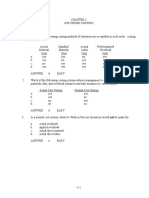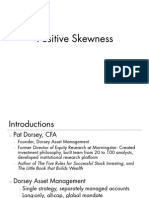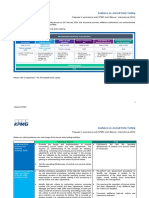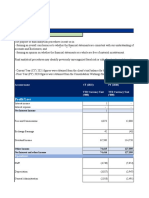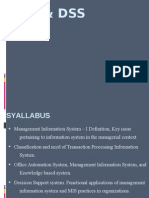67%(3)67% found this document useful (3 votes)
18K viewsProcess Costing Problems
Process Costing Problems
Uploaded by
Aries Bautista- Landers Company provided information on beginning and ending work in process inventory for May, including units and costs.
- Equivalent units schedules and cost per equivalent unit calculations were provided for both FIFO and weighted average methods.
- Costs were assigned to completed units and ending inventory using FIFO and weighted average.
Copyright:
© All Rights Reserved
Available Formats
Download as DOCX, PDF, TXT or read online from Scribd
Process Costing Problems
Process Costing Problems
Uploaded by
Aries Bautista67%(3)67% found this document useful (3 votes)
18K views9 pages- Landers Company provided information on beginning and ending work in process inventory for May, including units and costs.
- Equivalent units schedules and cost per equivalent unit calculations were provided for both FIFO and weighted average methods.
- Costs were assigned to completed units and ending inventory using FIFO and weighted average.
Original Description:
ASDASDASDASD
Copyright
© © All Rights Reserved
Available Formats
DOCX, PDF, TXT or read online from Scribd
Share this document
Read this document in other languages
Did you find this document useful?
Is this content inappropriate?
- Landers Company provided information on beginning and ending work in process inventory for May, including units and costs.
- Equivalent units schedules and cost per equivalent unit calculations were provided for both FIFO and weighted average methods.
- Costs were assigned to completed units and ending inventory using FIFO and weighted average.
Copyright:
© All Rights Reserved
Available Formats
Download as DOCX, PDF, TXT or read online from Scribd
Download as docx, pdf, or txt
67%(3)67% found this document useful (3 votes)
18K views9 pagesProcess Costing Problems
Process Costing Problems
Uploaded by
Aries Bautista- Landers Company provided information on beginning and ending work in process inventory for May, including units and costs.
- Equivalent units schedules and cost per equivalent unit calculations were provided for both FIFO and weighted average methods.
- Costs were assigned to completed units and ending inventory using FIFO and weighted average.
Copyright:
© All Rights Reserved
Available Formats
Download as DOCX, PDF, TXT or read online from Scribd
Download as docx, pdf, or txt
You are on page 1of 9
At a glance
Powered by AI
The document discusses cost flow assumptions and inventory costing methods for multiple companies using process costing. It covers calculating equivalent units and assigning costs to production and inventory under both FIFO and weighted average cost flow assumptions.
The two cost flow assumptions discussed are FIFO (first-in, first-out) and weighted average.
To calculate equivalent units under both cost flow assumptions, you determine beginning work in process, units started and completed during the period, abnormal spoilage/losses, and ending work in process. You then calculate equivalent units for each component (usually material and conversion costs).
Landers Company
Landers Company has the following information available for May:
Beginning Work in Process Inventory
(25% complete as to conversion)
10,000
units
Started
120,000
units
Ending Work in Process Inventory
(30% complete as to conversion)
30,000
units
Beginning Work in Process Inventory Costs:
Material
$ 2,100
Conversion
2,030
Current Period Costs:
Material
$ 33,000
Conversion
109,695
All material is added at the start of production and all products completed are transferred out.
1. Refer to Landers Company. Prepare an equivalent units schedule using the (a) FIFO and (b) weighted average method.
ANS:
(a) FIFO (b) Weighted Average
Mat. CC Mat. CC
BWIP
0 7,500
S & C
90,000 90,000
TO
100,000 100,000
EWIP
30,000 9,000
EI
30,000 9,000
EUP
120,000 106,500
EUP
130,000 109,000
2. Refer to Landers Company. Prepare a schedule showing the computation for cost per equivalent unit assuming the (a)
FIFO and (b) weighted average method.
(a) FIFO (b) Weighted Average
Mat. CC Mat. CC
Costs $33,000 $109,695 $ 35,100 $111,725
Eq Units 120,000 106,500 130,000 109,000
$.275/eq unit $ 1.03/eq
unit
$ .27/eq
unit
$ 1.025/eq
unit
Total cost/eq. unit $ 1.305/eq
unit
$ 1.295/eq
unit
3. Refer to Landers Company. Prepare a schedule showing the assignment of costs assuming the (a) FIFO and (b) weighted
average method.
(a) FIFO
Beginning Work in Process
$ 4,130
To complete (7,500 x $1.03) =
7,725
$ 11,855
Started and Completed
90,000 x $1.305 =
117,450
Total costs transferred out
$129,305
Ending Work in Process
30,000 x $ .275 =
$ 8,250
9,000 x $1.03 =
9,270
$ 17,520
Total costs accounted for
$146,825
(b) Weighted Average
Completed
100,000 x $1.295 =
$129,500
Ending Work in Process
30,000 x $ .27 =
$ 8,100
9,000 x $1.025 =
9,225
$ 17,325
Total costs accounted for
$146,825
4. The Sweet Temptations Company has two processing departments, Cooking and Packaging. Ingredients are placed into
production at the beginning of the process in Cooking, where they are formed into various shapes. When finished, they are
transferred into Packaging, where the candy is placed into heart and tuxedo boxes and covered with foil. All material
added in Packaging is considered as one material for convenience. Since the boxes contain a variety of candies, they are
considered partially complete until filled with the appropriate assortment. The following information relates to the two
departments for February 20X7:
Cooking Department:
Beginning WIP (30% complete as to conversion)
4,500
units
Units started this period
15,000
units
Ending WIP (60% complete as to conversion)
2,400
units
Packaging Department:
Beginning WIP (90% complete as to material, 80% complete as
to conversion)
1,000
units
Units started during period
?
Ending WIP (80% complete as to material and 80% complete as
to conversion)
500
units
a. Determine equivalent units of production for both departments using the weighted average method.
b. Determine equivalent units of production for both departments using the FIFO method.
a. Cooking Department
Materials Conversion
Costs
Transferred Out
17,100 17,100
Ending Work in Process
2,400 1,440
TOTAL EUP
19,500 18,540
Packaging Department
Transferred
In
Materials. Conversion
Costs
Transferred Out
17,600 17,600 17,600
Ending Work in Process
500 400 400
TOTAL EUP
18,100 18,000 18,000
b. Cooking Department
Materials Conversion
Costs
Beginning Work in Process
0 3,150
Transferred from Cooking
12,600 12,600
Ending Work in Process
2,400 1,440
TOTAL EUP
15,000 17,190
Packaging Department
Transferred
In
Materials Conversion
Costs
Beginning Work in Process
0 100 200
Transferred from Cooking
16,600 16,600 16,600
Ending Work in Process
500 400 400
TOTAL EUP
17,100 17,100 17,200
5. The following costs were accumulated by Department 2 of Hughes Company during April:
Cost Transferred
from Dept. 1
Material
Conversion
Costs
Total
Beginning Inventory
$ 17,050 $ 5,450 $ 22,500
Current Period Cost
184,000 $ 34,000 104,000 322,000
$ 201,050 $ 34,000 $ 109,450 $344,500
Production for April in Department 2 (in units):
WIP-April 1 2,000 60% complete
Complete period transferred 20,000
WIP-April 30 5,000 40% complete
Materials are not added in Department 2 until the very end of processing Department 2.
Required: Compute the cost of units completed and the value of ending WIP for:
a. Weighted average inventory
assumption
Dept 1 MAT CC
Complete
20,000 20,000 20,000
Eq-End WIP
5,000 0 2,000
EP-WA
25,000 20,000 22,000
Unit $201,050 = $8.042 $34,000 = $1.70 $109,450 = $4.975 = $14.717
Cost 25,000 20,000 22,000
End WIP Dept 1 = 5,000 x $8.042
= $40,210
CC = 2,000 units x $4.975
= 9,950
$50,160
COGM = $344,500 - $50,160 = $294,340
b. FIFO inventory assumption
Dept 1 MAT CC
Complete
20,000 20,000 20,000
Eq-End WIP
5,000 0 2,000
- Eq-Begin
(2,000) 0
(1,200)
EP-WA
23,000 20,000 20,800
Unit $184,000 = $8.00 $34,000 = $1.70 $104,000 = $5.00 = $14.70
Cost 23,000 20,000 20,800
End WIP Dept 1 = 5,000 units x $8.00
= $40,000
CC = 2,000 units x $5.00
= 10,000
$50,000
COGM = $344,500 - $50,000 = $294,500
6. The formula for a chemical compound requires one pound of Chemical X and one pound of Chemical Y. In the simplest
sense, one pound of Chemical X is processed in Department A and transferred to Department B for further processing
where one pound of Chemical Y is added when the process is 50 percent complete. When the processing is complete in
Department B, the finished compound is transferred to finished goods. The process is continuous, operating 24 hours a
day.
Normal spoilage occurs in Department A. Five percent of material is lost in the first few seconds of processing. No
spoilage occurs in Department B.
The following data are available for the month of August 20X6:
Dept. A Dept. B
Units in process, August 1
8,000 10,000
Stage of completion of beginning inventory
3/4 3/10
Units started or transferred in
50,000 ?
Units transferred out
46,500 ?
Units in process, August 31
? ?
Stage of completion of ending inventory
1/3 1/5
Units of Chemical Y added in Department B
44,500
ANS:
a. c.
Materials Conversion
Costs
PD Mat CC
46,500 46,500 44,500 44,500 44,500
9,000 3,000 12,000 0 2,400
(8,000) (6,000) (10,000) 0 (3,000)
47,500 43,500 46,500 44,500 43,900
b. Since the material in the second department goes in at the 50 percent point and the ending WIP
inventory is only at the 20 percent point, units complete is the same as the equivalents of
material 44,500, given that units started plus units in beginning WIP are equal to units
complete plus ending WIP 10,000 + 46,500 - 44,500 = 12,000 units in ending WIP.
7. Quigley Company manufactures a specialized product. Department 2 adds new material to the units received from
Department 1 at the end of process. A normal loss occurs early in processing. Production and cost data for Department 2
for the month of September are as follows:
Production record (in units):
In process, September 1-75% complete for processing cost
4,000
Received from Department 1
20,000
Completed and transferred to finished goods
16,000
Lost in processing (normal)
2,000
In process, September 30-2/3 complete for process cost
6,000
Cost Record:
Work in process inventory, September 1:
Preceding department cost
$ 620
Processing cost
2,000 $2,620
Cost from preceding department in September
1,800
Material cost for September
4,800
Processing cost for September
10,200
Equivalent production TI Material Conv. cost
Units complete
16,000 16,000 16,000
+ Equiv. ending WIP
6,000 0 4,000
= Equiv. prod. average
22,000 16,000 20,000
- Equiv. begin. WIP
(4,000) 0 (3,000)
= Equiv. prod. FIFO
18,000 16,000 17,000
Unit Cost Average Unit Cost FIFO
TI = $620 + 1,800 TI = $1,800
22,000 = $0.11 18,000 = $0.10
Mat =
$4,800
Mat = $4,800
16,000 = $0.30 16,000 = $0.30
CC = $2,000 + 10,200 CC = $10,200
20,000 = $0.61 17,000 = $0.60
End. WIP-WA End. WIP-FIFO
PD
6,000 x $0.11 = $ 660.00 6,000 x $0.10 = $ 600.00
CC
4,000 x $0.61 = 2,440.00 4,000 x $0.60 = 2,400.00
$3,100.00 $3,000.00
Cost of Goods Complete
WA FIFO
$19,420 - 3,100 = $16,320.00 $19,420 - 3,000 = $16,420.00
8. Copperfield Manufacturing employs a weighted average process costing system for its products. One product passes
through three departments (Molding, Assembly, and Finishing) during production. The following activity took place in
the Finishing Department during April 20x6.
Units in beginning inventory
4,200
Units transferred in from Assembly
42,000
Units spoiled
2,100
Good units transferred out
33,600
The costs per equivalent unit of production for each cost failure area as follows:
Cost of prior departments
$5.00
Raw material
1.00
Conversion
3.00
Total cost per EUP
$9.00
Raw material is added at the beginning of the Finishing process without changing the number of units being processed.
Work in process inventory was 40 percent complete as to conversion on April 30. All spoilage was discovered at final
inspection. Of the total units spoiled, 1,680 were within normal limits.
a.
TI Mat CC
Complete
33,600 33,600 33,600
+ Equiv WIP
10,500 10,500 4,200
+ Normal Sp
1,680 1,680 1,680
+ Abnor Sp
420 420 420
46,200 46,200 39,900
b. 33,600 x $9
$302,400
TC = 46,200 x $5
$231,000
1,680 x $9
15,120
46,200 x $1
46,200
$317,520
39,900 x $3
119,700
$396,900
c. 10,500 x $5
$52,500
10,500 x $1
10,500
4,200 x $3
12,600
$75,600
COGM = $396,900 - 75,600 - 3,780 = $317,520
d. $5 = $18,900 + X
46,200
X = $231,000 - 18,900 = $212,100
e. ABN = 420 x $9 = $3,780
420 x $9 = $3,780
9. Ashcroft Industries manufactures wood furniture. In the Lamination Department, varnish is added when the goods are 60
percent complete as to overhead. The units that are spoiled during processing are found upon inspection at the end of
production. Spoilage is considered discrete.
Production Data for May 20X8
Beginning inventory (80% complete as to labor, 70% complete as to
overhead)
1,000
units
Transferred in during month
7,450
units
Ending inventory (40% complete as to labor, 20% complete as to overhead)
1,500
units
Normal spoilage (found during final quality inspection)
100
units
Abnormal spoilage-found at 30% completion of direct labor and 15% of
conversion; the sanding machine was misaligned and scarred the chairs
200
units
All other units were transferred to finished goods
Cost Data for May 20X8
Beginning work in process inventory:
Prior department costs
$7,510
Varnish
950
Direct labor
2,194
Overhead
5,522 $ 16,176
Current period costs:
Prior department costs
$68,540
Varnish
7,015
Direct labor
23,000
Overhead
56,782 155,337
Total costs to account for
$171,513
TI MAT DL MOH
Complete
6,650 6,650 6,650 6,650
+ end
1,500 0 600 300
+ normal
100 100 100 100
+ abnormal
200 0 60 30
8,450 6,750 7,410 7,080
Unit Cost
End WIP
DL 600 x $3.40 =
$ 2,040
MOH 300 x $8.80 =
2,640
TI 1,500 x $9.00 =
13,500
$18,180
Abnormal Loss 60 x $3.40 =
$ 204
DL 30 x $8.80 =
264
MOH 200 x $9.00 =
1,800
TI
$ 2,268
COGM = $171,513 - 18,180 - 2,268 = $151,065
10. Consider the following data for a cooking department for the month of January:
Physical
Units
Work in process, beginning inventory*
11,000
Started during current period
74,000
To account for
85,000
Good units completed and transferred out during current
period:
From beginning work in process
11,000
Started and completed
50,000
Good units completed
61,000
Spoiled units
8,000
Work in process, ending inventory~
16,000
Accounted for
85,000
*Direct material, 100% complete; conversion costs, 25% complete
~Direct material, 100% complete; conversion costs, 75% complete
Inspection occurs when production is 100 percent completed. Normal spoilage is 11 percent of good units completed and
transferred out during the current period.
The following cost data are available:
Work in process, beginning inventory:
Direct material
$220,000
Conversion costs
30,000 $ 250,000
Costs added during current period:
Direct material
1,480,000
Conversion costs
942,000
Costs to account for
$2,672,000
Normal Sp = 11% x 61,000 = 6,710 units FIFO
Abnormal Sp = 8,000 - 6,710 = 1,290 units
Mat CC Mat =
$1,480,000 = $22.00
67,290
Complete
61,000 61,000
+ End
16,000 12,000
+ Ab Sp
1,290 1,290
CC =
$942,000 = 13.17
- Ave
78,290 74,290
71,540 $35.17
- Beg
(11,000) (2,750)
FIFO
67,290 71,540
WIP
Material
16,000 x
$22.00
$352,000
CC
12,000 x
$13.17
158,040
$510,040
Loss = 1,290 x $35.17
45,369
COGM = $2,672,000 - 510,040 - 45,369 = $2,116,591
11. Lumberton Industries has two departments. Department 1 uses FIFO costing and Department 2 uses weighted average.
Units are introduced into the process in Department 1 (this is the only material added in Department 1). Spoilage occurs
continuously through the department and normal spoilage should not exceed 10 percent of the units started.
Department 2 adds material (packaging) at the 75 percent completion point; this material does not cause an increase in the
number of units being processed. A quality control inspection takes place when the goods are 80 percent complete.
Spoilage should not exceed 5 percent of the units transferred in from Department 1.
The following production cost data are applicable for operations for August 20X7:
Department 1 Production Data
Beginning inventory (65% complete)
1,000
Units started
25,000
Units completed
22,000
Units in ending inventory (40% complete)
2,800
Department 1 Cost Data
Beginning inventory:
Material
$ 1,550
Conversion
2,300 $ 3,850
Current period:
Material
$38,080
Conversion
78,645 116,725
Total costs to account for
$120,575
Department 2 Production Data
Beginning inventory (90% complete)
8,000
Units transferred in
22,000
Units completed
24,000
Units in ending inventory (20% complete)
4,500
Department 2 Cost Data
Beginning inventory:
Transferred in
$40,800
Material
24,000
Conversion
4,320 $ 69,120*
Current period:
Transferred in
$113,700
Material`
53,775
Conversion
11,079 178,554
Total costs to account for
$247,674
*This may not be the same amount determined for Department 1; ignore any difference and use this figure.
a.
1
Mat CC Mat =
$38,080 = $ 1.60
23,800
Complete
22,000 22,000
+ End WIP
2,800
1,120
(2,800
x 4)
CC =
$78,645 = $ 3.50
24,800 23,120
22,470
- Beg WIP
(1,000) (650) (1,000
x .65)
End
WIP =
2,800 x
$1.60
= $ 4,480
23,800 22,470
1,120 x
$3.50
3.920
$ 8,400
COGM = $120,575 - 8,400 $112,175
b.
2
TI Mat CC Mat =
$ 77,775 = $ $3.05
25,500
Complete
24,000 24,000 24,000
+ End WIP
4,500 0 900
CC =
$ 15,399 = $ $0.59
+ Normal
1,100 1,120 880
26,100
+ Abnormal
400 400 320
30,000 25,500 26,100
TI =
$154,500 = $ 5.15
30,000
End WIP
Abn Loss
4,500 x $5.15
$23,175
400 x $3.05
$1,220
900 x $0.59
531
320 x $0.59
189
$23,706
400 x $5.15
2,060
$3,469
COGM = $247,674 - 23,706 - 3,469 = $220,499
12. Orange Company manufactures a single product. All material is added at the beginning of the process.
Costs Material Conversion Total
Beginning inventory
$ 30,000 $ 3,600 $ 33,600
Current period
885,120 335,088 1,220,208
Total costs
$915,120 $338,688 $1,253,808
UNITS
Beginning inventory (30% complete-
conversion)
6,000
units
Started
180,000
units
Completed
152,000
units
Ending inventory (70% complete-conversion)
20,000
units
Normal spoilage
4,800
units
ANS:
Mat CC
Units Complete
152,000 152,000
+ Equivalents Ending WIP
20,000 14,000
+ Abnormal Loss
9,200 5,520
(9,200 x .6)
= Equivalent Production-WA
181,200 171,520
= Equivalent Begin WIP
(6,000) (1,800)
= Equivalent Production-FIFO
175,200 169,720
Unit Costs:
WA FIFO
Mat $915,120 = $5.05 Mat $885,120 = $5.05
181,200 175,200
CC $338,688 = $1.97 CC $335,088 = $1.97
171,520 169,720
Ending WIP
Material 20,000 x $5.05
$101,000
CC 14,000 x $1.97
27,580
$128,580
Abnormal Spoilage
Material 9,200 x $5.05
$ 46,460
CC 5,520 x $1.97
10,874
$ 57,334
Cost of Good Transferred
1,253,808 - 128,580 - 57,334 = $1,067,894
13. Delightful Yogurt Company produces yogurt in two departments-Mixing and Finishing. In Mixing, all ingredients except
fruit are added at the start of production. In Finishing, fruit is added and then the mixture is placed into containers. Adding
the fruit to the basic yogurt mixture increases the volume transferred in by the number of gallons of fruit added. Any
spoilage that occurs is in the Finishing Department. Spoilage is detected just before the yogurt is placed into containers or
at the 98 percent completion point. All spoilage is abnormal.
Finishing Department
BWIP (100% fruit, 0% container, 30% CC)
5,000
gallons
Gallons transferred in
5,500
Gallons of fruit added
1,200
EWIP (100% fruit, 0% container, 60% CC)
1,700
gallons
Gallons transferred out
9,000
Abnormal spoilage
1,000
BWIP Costs:
Transferred In
$ 9,700
Fruit
10,500
CC
15,000
Current Costs:
Transferred In
12,400
Fruit
54,000
Containers
11,000
CC
98,000
Total Costs
$ 210,600
ANS: TI Fruit Container CC
Transferred Out
9,000 9,000 9,000 9,000
EWIP
1,700 1,700 0 1,020
Abnormal Spoilage
1,000 1,000 0 980
11,700 11,700 9,000 11,000
Costs:
TI Fruit Container CC
BWIP
$ 9,700 $10,500 $ 0 $ 15,000
Current
12,400 54,000 11,000 98,000
$22,100 $64,500 $11,000 $113,000
EUP
11,700 11,700 9,000 11,000
Per unit
$1.89 $5.51 $1.22 $10.27
Cost Assignment:
EWIP
1,700 x $1.89 =
$ 3,213
1,700 x $5.51 =
9,367
1,020 x $10.27 =
10,475 $ 23,055
Spoilage
1,000 x $1.89 =
$ 1,890
1,000 x $5.51 =
5,510
980 x $10.27 =
10,065 17,465
Transferred Out
$210,600 - 23,055 - 17,465 =
170,080
Total accounted for
$210,600
Hocking Company
The following information is available for Hocking Company for March 20X8. All materials are added at the start of
production.
Beginning Work in Process: (80% complete)
8,000
units
Started
35,000
units
Normal spoilage (continuous)
6,000
units
Abnormal spoilage
2,500
units
Ending Work in Process: (55% complete)
15,000
units
Transferred out
19,500
units
Beginning Work in Process Costs:
Material
$ 14,000
Conversion
45,000
Current Costs:
Material
50,000
Conversion
175,000
Total Costs
$ 284,000
FIFOMETHOD ANS:
BI 8,000 + Started 35,000 = Accountable for 43,000
Hocking Company
Cost Report
March 31, 20X8
Material CC
BWIP
8,000 0 1,600
S & C
11,500 11,500 11,500
EWIP
15,000 15,000 8,250
Norm
6,000 0 0
Abnorm.
2,500 2,500
Acctd. For
43,000 29,000 23,850
Material: $50,000/29,000 = $1.72
Conversion Costs: $175,000/23,850 = $7.34
Cost Assignment:
Ending Work in Process
15,000 x $1.72 =
$ 25,800
8,250 x $7.34 =
60,555 $ 86,355
Abnormal Spoilage
2,500 x $9.06 =
22,650
Cost Transferred Out
$284,000 - 86,355 - 22,650 =
174,995
Total costs accounted for
$ 284,000
WEIGHTEDAVE ANS:
Hocking Company
Cost Report
March 31, 20X8
Material CC
Transferred Out
19,500 19,500 19,500
Ending Work In Process
15,000 15,000 8,250
Normal Spoilage
6,000 0 0
Abnormal Spoilage 2,500
2,500 2,500
Accounted For
43,000 37,000 30,250
Material: $64,000/37,000 = $1.73
Conversion Costs: $220,000/30,250 = $ 7.27
Cost Assignment:
Ending Work in Process
15,000 x $1.73 =
$25,950
8,250 x $7.27 =
59,978 $ 85,928
Abnormal Spoilage
2,500 x $9.00 =
22,500
Transferred Out
$284,000 - 85,928 - 22,500 =
175,572
Total costs accounted for
$ 284,000
You might also like
- p2 - Guerrero Ch13Document40 pagesp2 - Guerrero Ch13JerichoPedragosa89% (18)
- Agile Extension To The BABOK Guide Agile Alliance Member PDFDocument134 pagesAgile Extension To The BABOK Guide Agile Alliance Member PDFshuchiarunikaNo ratings yet
- Mas Airline Ethical IssuesDocument3 pagesMas Airline Ethical IssuesMUAZ SYAKIR AHMAD SHA'ARANINo ratings yet
- CostAccounting Compre1Document15 pagesCostAccounting Compre1Ivan Fausto OranteNo ratings yet
- p2 - Guerrero Ch17Document19 pagesp2 - Guerrero Ch17JerichoPedragosa100% (2)
- Job Order Pure ProblemsDocument19 pagesJob Order Pure ProblemsolafedNo ratings yet
- Ch.13 TB (Service)Document14 pagesCh.13 TB (Service)Daniel GuevarraNo ratings yet
- Cost Old DeptalsDocument9 pagesCost Old Deptalsyugyeom rojas0% (1)
- CHAPTER 6 - Process Cost Accounting Additional ProcedueDocument28 pagesCHAPTER 6 - Process Cost Accounting Additional Proceduelap91% (11)
- Nestle Integration StrategyDocument4 pagesNestle Integration StrategyHimu Rahman50% (6)
- Process Costing Problems 1Document9 pagesProcess Costing Problems 1RoMaNo ratings yet
- AFAR 14D Cost Accounting (Job Order, Process Costing, JIT Backflush, Activity Based Costing, Joint and ByProducts, Standard Costing)Document9 pagesAFAR 14D Cost Accounting (Job Order, Process Costing, JIT Backflush, Activity Based Costing, Joint and ByProducts, Standard Costing)Jeepee John100% (1)
- CH 05Document42 pagesCH 05AudreyMae100% (1)
- Process Costing Quiz Spoiled UnitsDocument3 pagesProcess Costing Quiz Spoiled UnitsRafael Capunpon VallejosNo ratings yet
- Job Order CostingDocument6 pagesJob Order CostingRose Ann Juleth Licayan80% (5)
- Process Cost System: University of Santo Tomas Ust - Alfredo M. Velayo College of Accountancy SECOND TERM AY 2019-2020Document17 pagesProcess Cost System: University of Santo Tomas Ust - Alfredo M. Velayo College of Accountancy SECOND TERM AY 2019-2020allNo ratings yet
- Process Costing TEST BANKDocument7 pagesProcess Costing TEST BANKPatDabz67% (6)
- Test Bank Chap 7Document14 pagesTest Bank Chap 7Paula Dionisio100% (4)
- Final Quiz 3 - Standard Costing and Back Flush CostingDocument10 pagesFinal Quiz 3 - Standard Costing and Back Flush Costingpaolo pallesNo ratings yet
- Backflush - Costing - System - and - Activity - Based - Costing Answer KeyDocument14 pagesBackflush - Costing - System - and - Activity - Based - Costing Answer KeyAbegail A. AraojoNo ratings yet
- Job Order CostingDocument49 pagesJob Order CostingKuroko75% (8)
- 12 Accounting For OverheadDocument14 pages12 Accounting For OverheadSea Jean Paloma75% (4)
- Quiz 6 Process Costing SolutionsDocument7 pagesQuiz 6 Process Costing SolutionsralphalonzoNo ratings yet
- Chapter 6 Quiz and AssignmentDocument25 pagesChapter 6 Quiz and AssignmentSaeym SegoviaNo ratings yet
- Dorsey Asset MGMTDocument20 pagesDorsey Asset MGMTfab62No ratings yet
- Three Column Cash BookDocument3 pagesThree Column Cash Bookahmad381100% (1)
- Toward Human SustainabilityDocument8 pagesToward Human SustainabilityS ChettiarNo ratings yet
- Ust Multiple Rework SpoilageDocument6 pagesUst Multiple Rework SpoilageJessica Shirl Vipinosa100% (1)
- Cost Draft 2Document13 pagesCost Draft 2wynellamae100% (1)
- MODULE 3 Job Order Costing PDFDocument9 pagesMODULE 3 Job Order Costing PDFjay mhonsaint100% (1)
- Standard Costing QuizDocument2 pagesStandard Costing QuizLhorene Hope Dueñas100% (1)
- Job Order Costing QuizbowlDocument27 pagesJob Order Costing QuizbowlsarahbeeNo ratings yet
- Pre-Quiz 3 - Process CostingDocument10 pagesPre-Quiz 3 - Process Costingnicah shayne madayag100% (1)
- Afar Job Order Costing Spoilage DefectiveDocument4 pagesAfar Job Order Costing Spoilage DefectiveKaye Angelie UsogNo ratings yet
- Cost AccountingDocument9 pagesCost Accountingnicole friasNo ratings yet
- JUST IN TIME AND BACKFLUSH COSTING With Illustrative ProblemDocument7 pagesJUST IN TIME AND BACKFLUSH COSTING With Illustrative Problemenzo0% (1)
- Chap.13 Guerrero Job Order CostingDocument40 pagesChap.13 Guerrero Job Order CostingGeoff Macarate100% (1)
- Process CostingDocument10 pagesProcess CostingTricia Mae Fernandez67% (3)
- Exam Chapters 4-5 AnswersDocument12 pagesExam Chapters 4-5 AnswersKimberly A Alaniz63% (8)
- Cost Accounting Review QuestionsDocument12 pagesCost Accounting Review QuestionsYckzCasera100% (9)
- Acc123 Reviewer With AnswerDocument11 pagesAcc123 Reviewer With AnswerLianaNo ratings yet
- Final Term Quiz 3 On Cost of Production Report - FIFO CostingDocument4 pagesFinal Term Quiz 3 On Cost of Production Report - FIFO CostingYhenuel Josh LucasNo ratings yet
- Test Bank Chapter 4 Process CostingDocument52 pagesTest Bank Chapter 4 Process Costingelaine100% (1)
- Cost Accounting Pre-Finals ExaminationDocument7 pagesCost Accounting Pre-Finals ExaminationEricka GuisandoNo ratings yet
- Job Order CostingDocument14 pagesJob Order Costingmariciela100% (2)
- Midterm Reviewer Cost AccountingDocument14 pagesMidterm Reviewer Cost AccountingPrecious AnneNo ratings yet
- BCDocument3 pagesBCPrankyJelly0% (1)
- Cost Accounting Test Bank Part 16Document31 pagesCost Accounting Test Bank Part 16MariaNo ratings yet
- Backflush Costing System and Activity Based Costing QuestionsDocument23 pagesBackflush Costing System and Activity Based Costing QuestionsMedalla NikkoNo ratings yet
- Test Bank Principles of Cost Accounting 14th Edition VanderbeckDocument29 pagesTest Bank Principles of Cost Accounting 14th Edition VanderbeckFor GamesNo ratings yet
- Example DepartmentalDocument3 pagesExample DepartmentalPamela Galang60% (5)
- Process Costing ProblemsDocument9 pagesProcess Costing ProblemsmilleranNo ratings yet
- Long Problems Process Costing PDFDocument8 pagesLong Problems Process Costing PDFPatDabzNo ratings yet
- Chapter 6 Practice QuestionsDocument9 pagesChapter 6 Practice QuestionsAbdul Wajid Nazeer CheemaNo ratings yet
- Problems Process CostingDocument5 pagesProblems Process CostingakhieyhukieNo ratings yet
- Sanders CompanyDocument6 pagesSanders CompanyculadiNo ratings yet
- Process Costing Tutorial SheetDocument3 pagesProcess Costing Tutorial Sheets_camika7534No ratings yet
- Assignment Question AccDocument5 pagesAssignment Question AccruqayyahqaisaraNo ratings yet
- Pa2.M-1403 Process CostingDocument16 pagesPa2.M-1403 Process CostingJeric Israel0% (3)
- Acg 4361 Chapter 17 Study Probes SolutionDocument18 pagesAcg 4361 Chapter 17 Study Probes SolutionPatDabzNo ratings yet
- Programmazione e Controllo Esercizi Capi PDFDocument43 pagesProgrammazione e Controllo Esercizi Capi PDFHeap Ke XinNo ratings yet
- Process CostingDocument3 pagesProcess CostingenzoNo ratings yet
- P2 BautistaDocument8 pagesP2 BautistaMedalla NikkoNo ratings yet
- ProcessDocument11 pagesProcessElaine YapNo ratings yet
- AP 1402 CashDocument13 pagesAP 1402 CashElaine YapNo ratings yet
- Quizzes For Finals 1 Compilation Chap6,7,1,2Document35 pagesQuizzes For Finals 1 Compilation Chap6,7,1,2Saeym SegoviaNo ratings yet
- MathDocument4 pagesMathAries BautistaNo ratings yet
- Corazon AquinoDocument7 pagesCorazon AquinoAries BautistaNo ratings yet
- History 2023 AttendanceDocument1 pageHistory 2023 AttendanceAries BautistaNo ratings yet
- Answer UtsDocument1 pageAnswer UtsAries BautistaNo ratings yet
- Reading Philippine History AttendanceDocument3 pagesReading Philippine History AttendanceAries BautistaNo ratings yet
- GROUPINHDocument20 pagesGROUPINHAries BautistaNo ratings yet
- Loan FeesDocument19 pagesLoan FeesAries BautistaNo ratings yet
- GD MJE - Posted On HolidaysDocument5 pagesGD MJE - Posted On HolidaysAries BautistaNo ratings yet
- Guidance On Journal Entries - KAM 3.2.20 (Ver01.20)Document9 pagesGuidance On Journal Entries - KAM 3.2.20 (Ver01.20)Aries BautistaNo ratings yet
- Final AnalyticsDocument10 pagesFinal AnalyticsAries BautistaNo ratings yet
- Revenue Sample - DominicaDocument24 pagesRevenue Sample - DominicaAries BautistaNo ratings yet
- Consol Pack March22 LCDocument151 pagesConsol Pack March22 LCAries BautistaNo ratings yet
- ANT Tax Comp FY22 Mar 22 13.04.22Document377 pagesANT Tax Comp FY22 Mar 22 13.04.22Aries BautistaNo ratings yet
- Sustainability Report 21 22 ENGDocument85 pagesSustainability Report 21 22 ENGAries BautistaNo ratings yet
- Consol Pack Mar22 ANTDocument149 pagesConsol Pack Mar22 ANTAries BautistaNo ratings yet
- Online Skills Lab Pa of A Normal Pregnant Client Jamosmos 1 1Document12 pagesOnline Skills Lab Pa of A Normal Pregnant Client Jamosmos 1 1Aries BautistaNo ratings yet
- ST Lucia March 2022 TBDocument26 pagesST Lucia March 2022 TBAries BautistaNo ratings yet
- Patient History QuestionnaireDocument6 pagesPatient History QuestionnaireAries BautistaNo ratings yet
- Audit Program-Long Term DepositDocument3 pagesAudit Program-Long Term DepositAries BautistaNo ratings yet
- Ho Ren SoDocument3 pagesHo Ren Somikedohr-1No ratings yet
- Hazard Identification, Risk Assessment and Risk Control, HIRARCDocument2 pagesHazard Identification, Risk Assessment and Risk Control, HIRARCMiguel AlvaradoNo ratings yet
- Assignment of SBMDocument22 pagesAssignment of SBMOmerhayat Mian100% (1)
- Inventory v3Document5 pagesInventory v3Jerome ContanteNo ratings yet
- 3.5 Provisional ALT DetailsDocument1 page3.5 Provisional ALT DetailsHeidi TaboraNo ratings yet
- Kitov China DealDocument1 pageKitov China DealAnonymous ipErpL6No ratings yet
- Mis & DSS: Unit-IiDocument59 pagesMis & DSS: Unit-IiSHRID46No ratings yet
- AFIN1Document6 pagesAFIN1Abs PangaderNo ratings yet
- 4.1.2 HEPA Filter Categories Chart IEST RP CC001 4 PDFDocument1 page4.1.2 HEPA Filter Categories Chart IEST RP CC001 4 PDFGAMER BOY GONo ratings yet
- HBLDocument42 pagesHBLAsif Rasool ChannaNo ratings yet
- Endowment Plan (PPS)Document2 pagesEndowment Plan (PPS)Lee SmithNo ratings yet
- MX3APPDocument1 pageMX3APPTravelwise VacationsNo ratings yet
- Fairview Mall Map PDFDocument2 pagesFairview Mall Map PDFChristineNo ratings yet
- OM Assig MCDDocument1 pageOM Assig MCDMeetaliSaxenaNo ratings yet
- Solution International Accounting Chapter 4Document2 pagesSolution International Accounting Chapter 4Henny FaustaNo ratings yet
- PKT Brochure 1Document8 pagesPKT Brochure 1Aries LengNo ratings yet
- Marketing Strategies of Pepsico in KolkataDocument66 pagesMarketing Strategies of Pepsico in KolkataKushal DeyNo ratings yet
- BSNL Land LineDocument117 pagesBSNL Land Linenits231No ratings yet
- A Project ReportDocument50 pagesA Project Reportmallik007007No ratings yet
- Pricingoptions by BlackscholesDocument98 pagesPricingoptions by BlackscholesNitish TanwarNo ratings yet
- Annex 1 UndertakingsDocument4 pagesAnnex 1 UndertakingsSavoir PenNo ratings yet
- Biography of Internationally Celebrated Younger Nigerian Entrepreneur Arrested by FBI For A 12million FraudjjjuvDocument2 pagesBiography of Internationally Celebrated Younger Nigerian Entrepreneur Arrested by FBI For A 12million Fraudjjjuvedgerscreen3No ratings yet
- EntrepreneursDocument6 pagesEntrepreneursLeigh-ann GarroteNo ratings yet
- Internal ControlsDocument18 pagesInternal ControlsManikant SAhNo ratings yet












